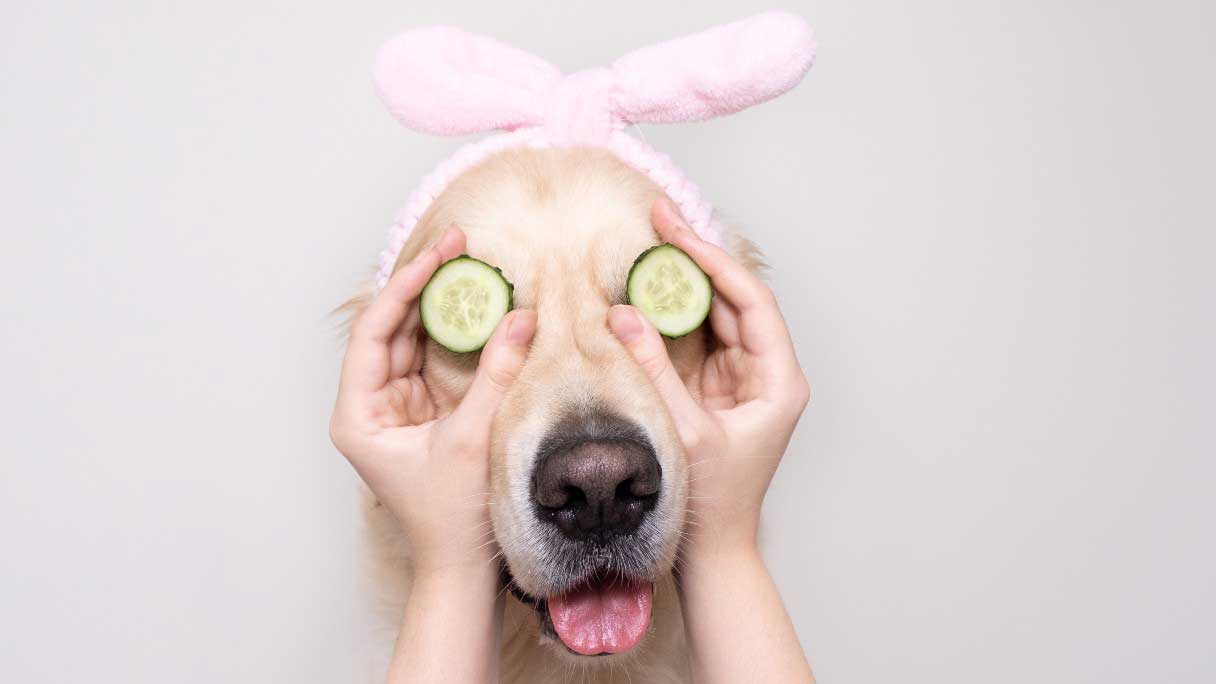Whether your dog is smelly, itchy or loves rolling around in mud, bathing is an important part of good pet hygiene. Besides cleaning off dirt and muck, bathing your dog can help minimize shedding and keep their coat and skin healthy and free of parasites.1 It can ease some medical conditions, too.2
But sometimes, bathing your dog is easier said than done. Here's everything you need to know about how to bathe your dog, including how often, what to use and what to do if your dog hates it.
What You Need to Wash Your Dog
Grooming products like deshedding tools and brushes can help maintain your dog's coat in between washes.2 You'll also need a quality dog shampoo, which may be medicated if your dog has a skin issue, or even dander-removing if the humans in your home have allergies.2 If your dog doesn't seem to have any special needs, a shampoo with oatmeal tends to work well.3
Other items that could be helpful to have in your grooming toolbox include:3
- Washcloth for your dog's face
- Towels for the floor and for drying off
- Ear cleaner
- Nail clippers
- Grooming wipes for in between baths
8 Steps for Washing Your Dog
Before washing your dog, decide where you're going to do it. Smaller dogs might fit in the bathtub, or maybe you want to bathe them outside in a plastic pool or tub. You could also take your dog to a dog-washing facility where they have tubs and all the tools you need for a small fee.
Now that you're ready:1
- Take your dog out to relieve themselves before getting in the bath so they don't have any accidents and/or don't need to go mid-bath.
- Brush your dog to get out any tangles or mats.
- Test the water to ensure that it's lukewarm before putting your dog in it.
- If your dog is anxious, talk to them in a calm voice. You don't need to go overboard, but it's OK to reassure them if they're feeling nervous — just like you would for a person.
- Lather them up with dog shampoo.
- Rinse your dog at least twice to make sure all the shampoo is gone (leaving residue can irritate your dog's skin).
- Towel off your dog and let them air-dry, or get a specialized dryer just for dogs (a human hair dryer can dry out their skin).
- Reward your dog with a treat, a toy or some pets for tolerating the bath, regardless of how well they did (or didn't) handle it.
Be careful around your dog's eyes, ears, nose and mouth and use a washcloth with just water on it for these areas. Even if a shampoo is tear-free, it could still irritate your dog. You also don't want your dog to swallow any of the dirty water or shampoo.4
Use specialized treatments and tools to clean your dog's ears. Ask your vet for more advice based on your dog's breed and ear type.4
At the end of the day, if bathing and grooming your dog is too stressful or you have to do it often, it might be worth hiring a professional, especially if your dog needs regular haircuts. If you notice that your dog has clumpy fur or has gotten burs stuck in their fur, a professional will have the tools to remove those things safely and comfortably.
How Often Should You Wash Your Dog?
Dogs have different bathing needs based on breed, length of coat, activity level and medical conditions.2
Dogs with shorter coats might be able to get just a little wipe down or a quick rinse versus a full wash, depending on their activity level. Medium-to-long coats might need to be bathed every four to six weeks, while thick or double-coated breeds (like Labradors, golden retrievers or Siberian huskies) may not be bathed as often. Just as bathing can help moisturize the skin and coat, overwashing can also strip oil from the skin and make your dog itchy and uncomfortable.2
It may seem counterintuitive, but hairless breeds require more bathing, up to weekly. Other breeds, like the Puli, don't get washed while their coat is corded.2
Start When Your Dog Is a Puppy
The key to conditioning your dog to at least tolerate grooming and bathing as they get older is to introduce them to it when they're a puppy. Start with quarterly baths and get your puppy used to the process with just water and a washcloth or sponge. Make sure the water isn't too hot or too cold and give your pup a little massage. If they seem scared or anxious, it's OK to keep sessions short at first and slowly build up to longer sessions with shampoo and water.4
If you get an adult or older dog, it's still a good idea to introduce them to the process slowly if they seem anxious about being in the water or getting a bath.
Regardless of breed, if your dog likes to romp around in the woods and get dirty on the regular, they may need a bath more often than a dog who spends more time indoors, or if they are more active in the summer than the winter. Either way, your vet can help you decide the best bathing cadence for your dog and their needs.
CareCredit Credit Card Financing for Dogs
Taking good care of your pet's well-being from nose to tail is essential. Make sure to stay up to date on their regular checkups at the vet to help keep your pet happy and healthy for a lifetime of love. You can use your CareCredit credit card for pet care throughout the year for routine veterinary services as well as emergencies and surgeries.* Apply today and use our Acceptance Locator to find a veterinarian near you that accepts CareCredit.
CareCredit is there for you and your pet every step of the way; continue your wellness journey by downloading the CareCredit Mobile App to manage your account, find a provider on the go and easily access the Well U hub for more great articles, podcasts and videos.
Author Bio
Abbie Mood is a freelance writer with more than 10 years of experience. She has worked with clients of all sizes to create compelling content and she has written for the American Kennel Club, Marriott Bonvoy, Women's Health Online, Headspace and more.








